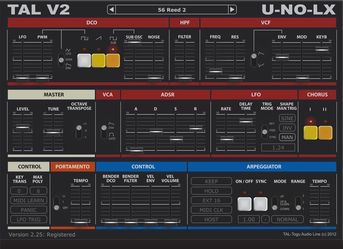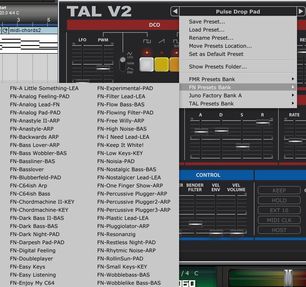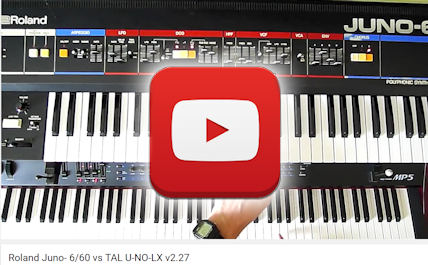TAL U-NO-LX Review
Many of us are thankful for Switzerland’s Patrick Kunz and his full line of TAL (Togo Audio Line) virtual synths and plug-ins.
Very thankful. Many DAWs have been blessed with TAL audio products over the past 6 years. There has been the illustrious TAL-chorus, the reliable, ear-pleasing Tal-Reverb (II and III), the fluid, silky TAL DUB-Delays, and the easy-to-dial in TAL Effects.
While we’re listing the wealth of products that TAL have blessed us with, let’s not omit the worthy VA synths, TAL-Elec7ro, TAL-NoiseMaker and the perennial U-NO-60.
After years of giving his hard work and exemplary programming efforts away for free, Mr. Kunz now offers the FINEST “Roland Juno 60” emulation that has ever been heard ‘In The Box’ for both MAC and PC. Originally slated for a MSRP of $70, TAL made U-NO-LX available for a paltry $17 as a pre-release offer. At present, the RRP is only $60 (USD). I strongly recommend that interested parties hurry over to the developer’s web site to grab this VSTi now! Once the news gets out about just how “good” this TRUE-modelled VA synth is, I suspect that there will be a whole new generation of synth players who will consider the $70 price tag a small amount to pay. Preamble:
You ask: “So what’s the big deal? There are many so-called vintage synths on the market, What makes this one special? The previous version was free; it was pretty good. Why should I pay for it now?”
I’m glad you asked, but before I directly answer, let me draw a backdrop. I was grooving along to FM waves in the era that produced such memorable hits as Flock of Seagulls,“I Ran So Far Away” and Eurythmics, “Sweet Dreams Are Made of This”. I suspect that there are many more like me, who fondly remember those types of classic synth sounds and still consider them relevant. Why should classic synth sounds be considered any more antiquated than other vintage instruments? After all, there are myriads of guitarists in the pursuit of ‘pure’ tone pining for vintage tube amps from the 60s and 70s. Umpteen old-skool keyboardists search for mint-condition Mark I Rhodes and A200 Wurlis. Is it unreasonable to consider that countless synth enthusiasts feel the same way about time-honoured synthesizers? By this reviewer’s estimation, U-NO-LX is truly the world’s most authentic-sounding virtual Juno synth. I’ve heard Juno sample libraries that are certainly realistic-sounding, but they don’t possess the breathing, organic, quality that this incredibly well-programmed VSTi oozes. The developer’s intricate attention-to-detail, and careful consideration of the original hardware’s sonic subtleties, is clearly evidenced in U-NO-LX. Even the original hardware presets have been painstakingly recreated for an unprecedented level of authenticity. The new, larger GUI is a very, very kewl homage to a beautiful, mint-condition Roland Juno 60, circa 1982. U-NO-LX remains true-blue to the original hardware whilst blessing us with a few advantages of present-day technology. For example, TAL doubles the original, six-voice polyphony specs and favors us with 12 voices. The original hardware was not a midi device. Thankfully, U-NO-LX is entirely midi controllable and even outfitted with easy-breezy midi-learn functionality. The luscious pads, breathy, chorused strings, and stabbing, hearty basses that popularized the original are all here – with very great accuracy. A laudable quality observed in Mr. Patrick Kunz himself is his continuing commitment to bettering and refining U-NO-LX. Since its initial release in August of 2012, TAL has regularly updated and improved this exceptional instrument. Every reported bug or potential bug is swiftly stamped out and eradicated as soon as it is detected. Mr. Kunz maintains open, transparent communication with TAL customers. His customer support model is exemplary. By this reviewer’s estimation, Mr. Kunz, and Variety of Sound’s famous “Bootsy”, have both well-earned the title of “Philanthropist”. There is an obvious, diverse selection of high quality virtual synthesizers currently on the market. This isn’t a soul-enlightening epiphany. Anyone with an internet connection, and even a remote interest in the topic, knows it. What we’re puzzling over in this article, is the defining quality and unique characteristics of the TAL U-NO-LX. To briefly teach the younger readers about why the Roland Juno 6 and Juno 60 are so important in electronic music history, indulge me just a wee bit more with one more prefacing paragraph. The Juno 60 was a six-voiced, single oscillator, polyphonic synth. Back in 1982, this was an incredible degree of polyphony for an inexpensive synth that only cost about $1700 on the street. No one knew what “DCO” meant. Digital was still considered to be in its infancy, and CDs were known about by only the “geekiest” of “nerds”. “MP3” could have easily been confused for “Me pee three times.” There was no such thing as a “Personal Computer”. Sony Walkmans weighed almost a pound (half a kilogram) and very few of them provided the modern features of “auto rewind” or “reverse-play”. The new “DCO” technology meant that unheard-of tuning stability could be realized without the inherent annoyance of VCO drift. This was a very eagerly welcomed improvement over previous designs; especially where the built-in 3 octave arpeggiator was concerned. The most notable characteristic of this new, affordable, high-tech instrument was its onboard chorus. The Roland chorus effect is *still the grail of chorusing effects; these 30+ years later.
Installation and Authorization:
"Easy, breezy, beautiful color gir . . ." Arghh! Oh no! That silly girlie commercial from the eighties almost had me for a moment there. Whew, all this 80s chatter even has me remembering old TV-commercial jingles. Oh well, the point is that this spiffy little VSTi is an “easy, breezy” 2MB download. It installs in seconds using a typical Windows/MAC installer. Upon receipt of purchase, the buyer is issued a 64 alpha-numeric character serial code which is delivered via email. Unless authorized, the software will operate unrestricted, minus the ability to save or edit presets, nor have its current state saved in a HOST/DAW. To authorize, the user simply clicks on the Preset name, located in top center of the GUI, and then clicks on “Register Plugin”. Et voila. Registration takes effect immediately and doesn’t require relaunching the plug-in itself or reloading the DAW/Host. Yay! No dongles. No C/R protection. Piracy totally blows. It sucks. Software theft is a crime and it is NOT victimless. Developers, such as Patrick Kunz, deserve very great respect and appreciation. Personally, I am very grateful to TAL for the ease and convenience of serial code authorization. 5 STARS!
Visuals:
The U-NO-LX GUI is expertly crafted. The colors are “bang a gong” right on, and very closely match the original hardware’s colors. The impeccably well-mimicked sliders, switches and buttons are just so much fun to play with. You won’t find any LED or digital readouts on this soldier of sound. It’s “analogism” all the way here, baby. Dude, If ya spend too much time with this “Righteous” synth, you’ll be spiking a mullet and humming Duran Duran songs. “You know it.” The main background color is a no-nonsense charcoal-grey which let the bold, white typeface to jump out. Each control region is sectioned off with thin, white lines and large, easy-to-read labels. Much like the original hardware, the interface is designed to be intuitive and easily-tweaked. Even a brand new synth-novice will quickly become familiar with this rugged, old-skool arrangement. The sliders on this soft-synth are some of the smoothest I have ever tweaked with a computer-mouse. Holding down the shift key gives us good ol’ granular, fine control over the sliders. The user’s manual doesn’t indicate a method of resetting a slider to its default value, and I haven’t found a keyboard/mouse combination to accomplish it. Even the decidedly 80s looking glow of classic red LEDs are imitated when a button is pushed in. There are three rows of synth controls; each being easy to navigate and manipulate. [Top Row]
Starting at the top, we have the DCO, HPF, and VCF areas. The DCO contains four sliders (LFO, PWM, Sub Osc and Noise), a PWM modulation assignment switch and three push buttons. The buttons activate/deactivate the three alias-free waveforms available in U-NO-LX; pulse, saw, and rectangle sub-oscillated. Any combination of these can be used at a time.
Next, we have a single slider to control the amount of High Pass Filtering. The frequency value itself is not "seen" by any numeric value here; this is a case of good ol' fashioned "using your ears". Along the top right you will find the VCF (Voltage Controlled Filter) grouping. Five sliders to control Frequency, Resonance, Envelope intensity, MOD (LFO intesnsity) and Keyboard control are provided. (The latter controls the intensity by which the filter follows the current key.) There is a switch to assign normal or inverted envelope mode. [Middle Row]
From the left, there is the “MASTER” section granting volume, global tuning, and a choice of -1, 0, or +1 octave transposition. Next is the VCA/ADSR panel. A solitary two-position switch makes it possible to switch between volume ENV and GATE mode. The volume will not be shaped when GATE is enabled. The Attack, Decay, Sustain and Release sliders directly affect the volume when ENV is switched ON.
Along side the ADSR we find the LFO segment. We’re provided two sliders for rate and delay time respectively. There is a switch for assigning the trigger mode. Trigger mode choices are: Key (Triggers the LFO to the note on event), Free, and Sync (Synced to HOST tempo). A “Shape” menu lets you select the waveform type: TRI (Triangle), REC (Rectangle), SAW, RND (Random). The “MAN” button can be enabled and tells the LFO to be triggered by the LFO TRIG button and DELAY TIME controls the fade-in speed. Featuring the hallmark Roland-like Chorus effects, the user is given the option of type 1, type II, or both chorusing modes in tandem. [Third Row]
The bottom row begins with the “CONTROL” panel. This is where a user can key transpose -24/24+ semitones. The number of polyphonic voices can be set from 1 to 12. MIDI Learn lets you assign a midi controller to each controllable parameter on the synth.
Adjacent to the initial Control panel is the “PORTAMENTO” segment. Here the performer is free to choose off, standard mode 1 (where overlapped notes only are affected) and mode 2 (each note is played with portamento). The effect can also be tempo controlled with a slider. Directly beside the Portamento parameters, we have the Pitch wheel and velocity “CONTROL” section. Four sliders grant user-defined manipulation of pitch wheel intensity, pitch bend filtering, velocity envelope and how much keyboard velocity affects a note’s actual volume. Completing the interface is the OH-so-easy-to-use, classic “ARPEGGIATOR” cluster. The arp section can be configured in standard up, down and randomized up/down modes. It can stick to the actual notes played, or can sweep up to 3 octaves. The arpeggiation can be synced to host/DAW and be assigned to 1/8, 1/16, 1/32, and finally, 1/64 notes per measure. 
Presets a Plenty: As I’ve already mentioned, the original Roland factory presets have been very carefully replicated. To accompany the original presets, TAL bundles three more well-rounded banks of presets: FMR, FN, and TAL. Each of these additional banks is well categorized alphabetically. The presets menu is conveniently placed at the top of the GUI.
Sound Quality:
Yep. This one’s the real deal. Some synth historians consider the early DCO synths, such as Korg Polysix and Roland Junos, to be very “cheesy” sounding. This may be true, but it isn’t cheap ol’ processed cheese slices; it’s more like carefully-cultured Brie or Havarti. *Grin. The Portamento function let’s your 80s ‘plastic-sounds’ stretch with delicious bubblegum elasticity. The single oscillator’s pulse and saw waves are capable of producing the rich, big sounds that were so popularized in the early eighties. A spiffy, rectangular sub-oscillator with its variable range of noise combines nicely with the tasty warble of retro LFO modulation. U-NO-LX is sure to bring out the “Berlin” in any one of us. 24 dB Low-Pass resonance filtering keeps everything sounding nice n’ smooth. There is 4x oversampling built-in to keep sample aliasing to an absolute minimum. Accurate zero-feedback delay filtering, combined with the oversampling, allow for a smooth-sounding maximum filter sweep up to 20 Khz. The filter cut-off has been carefully modelled to exhibit the inaccuracies of a real analogue synth. It is “spread” around the main peak like digital cheese-whiz on 12 bit sample toast. *Cheesy analogy in keeping with the era . . . Two distinct harmonic distortion peaks are also part of the Juno-60 filter. These harmonic peaks have been delicately replicated in this phenomenally accurate clone. I like this soft-synth. It can chirp, sing, hum, stab, drone, arp and pad it’s way across the full spectrum of the early eighties digital horizon. It sounds like the real deal. It looks like the real deal. It “feels” like the real deal. The price point is a real deal too. *wink. Just for grins n' giggles, here a "cheesy" little 80s-sounding pop mish-mish that I threw together using ONLY the factory bank presets. This mini clip shows off classic as well as randomized arpeggiation. The initial midi clip (pads) is courtesy of Satya Choudhury; accompaniment by Bro. Charles
CPU Consumption:
TAL U-NO-LX is moderate to light on CPU. How marvellous. How perfectly dandy! We have an old-skool synth that runs happily on old-skool computers. It is important to bear in mind that ambitious arpeggiation and chorusing will increase CPU load noticeably. Portions of LFO functionality have been hard-coded to use 4x anti-aliasing. While this keeps audio quality high, it does have an impact on performance. This soft-synth may be considered generally light on CPU by today’s standards. 5 BIG, BRIGHT Stars! Concluding Remarks: I anticipate great things for TAL in the not-too-distant future. U-NO-LX is seen on the horizon as a worthy peer to any offering, from any developer; independent or commercial. I would be very grateful if TAL were to release other classic VA synths of this calibre. It is this reviewer’s findings that TAL U-NO-LX is the reigning prince of virtual Juno synths; sample-based or VSTi.
All too many have unintentionally dismissed this fantastic instrument as a “freebie turned payware” product. To that sentiment, I answer: Just because some of us have been spoiled by TAL’s gracious generosity, does not mean, for one second, that this outstanding developer isn’t deserving of our well-spent appreciation.
I recently reviewed Rob Papen’s Predator synth; It is capable of recreating some very nostalgic tones n’ bleeps. I greatly admire the magnificent, true-to-spec, analog sounds produced by SonicProject’s Oberhiem clone, OP-X Pro II. Arturia’s collection of Classic “Vs” is unquestionably desirable. I will be reviewing the powerful, analogue-greatness of Xils-Lab’s PolyKB II in the not-too-distant future. There are many more feature-rich soft-synths that are devotedly embraced by the electronic music community. Nevertheless, not a single one of them so accurately reproduces the self-oscillating resonance that “is” the hailed prince of DCO; the Juno 60 by Roland. *DCO (Digitally Controlled Oscillation) PROS: - Arguably THE BEST Juno clone available. - Affordable. - Very authentic sounding. - Abundant, well-categorized presets management. - Attractive user interface that closely resembles the original instrument. - Smooth, high quality filtering. - Easy-to-use & Easy-to-learn. - Well-written user’s manual. - Friendly, proactive product support. - Regularly updated and maintained. - No dongles, call/response challenges, nor invasive piracy protection overhead. - 32 & 64 bit for both MAC & PC (AU or VST) CONS: - $40 is too small a price for such an accurate, well-modelled classic synth clone. *Grin. For this and other TAL goodies, visit the developer's web site. http://kunz.corrupt.ch
Brother Charles is a freelance writer, Gospel music artist and minister. Charles had been a professional touring musician during the nineties; working primarily as a lead guitarist in the Canadian country music industry. Brother Charles is also involved with music production and quality home recording.
9 Comments
Bro. Charles
5/12/2013 09:21:38 pm
Thanks a million, Adam B. I'm really glad that you liked the review. U-NO-LX is a fantastic old-skool synth. :)
Reply
Halma
5/12/2013 11:47:53 pm
Pretty good review. Can´t compare the VST to the real deal because I haven´r heard or played one on my own.
Reply
Bro. Charles
5/13/2013 12:33:13 am
Thanks very much, Sebastian.
Reply
1/29/2014 03:34:57 am
Interesting post, i love to visit your blog everyday
Reply
Bro. Charles
11/1/2014 03:18:47 pm
Thanks much, fotograf. I'm a huge fan of TAL creations. :)
Reply
Synth master
8/18/2015 04:57:19 am
Hey! I have downloaded the U-NO-LX, but it seems to make this weird background noise every 60 seconds. Does anyone have the same problem and is able to help?
Reply
Brother Charles
7/3/2022 07:46:35 pm
Yes, that’s the demo / copy protection. Once buy a license and register the software, that “noise” magically disappears.
Reply
Your comment will be posted after it is approved.
Leave a Reply. |
NO SPAM! IK Multimedia Group Buy
FX Pick & Mix Group Buy - up to 16 for the price of 1
Will You Help?Web hosting is getting more and more expensive all the time, and Reviewer's Revival is NOT funded nor supported by any commercial enterprise or business. A donation of any amount is greatly appreciated. Even $2 or $3 for a coffee - every little bit helps. Thanks very much.
Legal BlurbAll of the articles published on Reviewer's Revival are undertaken to be purely objective, impartial reviews. Reviewer's Revival is not owned, funded-by, nor hired by any company or individual. Reviewer's Revival is the sole property of, and solely under the discretion and direction of Brother Charles. |







 15% OFF Summer Sale!
15% OFF Summer Sale!
 RSS Feed
RSS Feed

